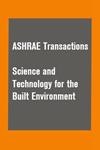曲轴驱动单长镍钛管压缩弹热冷却器的研制
IF 1.6
4区 工程技术
Q3 CONSTRUCTION & BUILDING TECHNOLOGY
Science and Technology for the Built Environment
Pub Date : 2023-08-24
DOI:10.1080/23744731.2023.2242756
引用次数: 4
摘要
摘要/ abstract摘要:地热能冷却系统在运行过程中对环境无影响,实现结构紧凑,特别是驱动装置紧凑,对其商业化具有重要意义。在本文中,一个紧凑的,独立的曲轴驱动的单一长镍钛管压缩弹热冷却器的开发。设计并制造了曲轴驱动器,用于驱动压缩弹性热再生器,该曲轴驱动器采用单根长多晶超弹性NiTi形状记忆合金管(外径5mm,壁厚1mm,初始长度305mm)。冷却器采用新型陶瓷隔热板设计,减少了镍钛管到不锈钢加载头的导热损失。采用同步热电偶和红外热像仪对冷却器的冷却性能进行了表征,测得比冷却(加热)功率、温度跨度和性能系数分别高达65(125)W·kg−1、9.1 K和5.0。分析了温度跨度、比冷(热)功率和性能系数随运行周期和温度升程的变化规律。能量分析表明,传热流体仅发挥了NiTi管产生的潜热的14%,这表明通过改进蓄热器结构可以提高冷却性能。感谢香港科技大学张宇晨先生、雷家晨先生、叶俊贤先生和黄志忠先生对单长镍钛管压缩弹热冷却器曲轴驱动器的有益讨论和构建。披露声明作者未报告潜在的利益冲突。项目资助:国家自然科学基金项目(批准号:52206224)、河北科技大学人才招聘自然科学研究启动基金项目(批准号:202310082008)、中国国家大学生创新创业培养计划项目(批准号:202310082008);IERF202003)。程思远,博士,助理教授。李政宇,理学学士,在读博士。李翁札,本科在读。刘朔阳,是一名本科生。杨福,是一名本科生。赵亚涛,本科在读。张梦怡,是一名本科生。本文章由计算机程序翻译,如有差异,请以英文原文为准。
Development of a crankshaft driven single long NiTi tube compressive elastocaloric cooler
AbstractElastocaloric cooling has no environmental effects during operation, and achieving a compact structure especially the driver is significant for its commercialization. In this article, a compact, standalone crankshaft driven single long NiTi tube compressive elastocaloric cooler is developed. A crankshaft driver was designed and fabricated to drive a compressive elastocaloric regenerator utilizing a single long polycrystalline superelastic NiTi shape memory alloy tube (outer diameter 5 mm, wall thickness 1 mm, and initial length 305 mm). A novel design of ceramic heat insulation plate was applied to the cooler to reduce the conduction heat loss from the NiTi tube to the stainless-steel loading heads. The cooling performance of the cooler was characterized using synchronized thermocouples and infrared thermography, and the specific cooling(heating) power, temperature span, and coefficient of performance of up to 65(125) W·kg−1, 9.1 K, and 5.0, respectively were measured. The progressions of the temperature span, specific cooling(heating) power, and coefficient of performance with the operation cycle and temperature lift were analyzed. An energy analysis revealed that the heat transfer fluid carried out only 14% of the latent heat generated by the NiTi tube, which demonstrated a potential to enhance the cooling performance by the improvement in the regenerator structure. AcknowledgementsWe thank Mr. Yuchen Zhang, Mr. Jiachen Lei, Mr. Junxian Ye, and Mr. William Chi Chung Wong in the Hong Kong University of Science and Technology for the beneficial discussions and construction of the crankshaft driver in the single long NiTi tube compressive elastocaloric cooler.Disclosure statementNo potential conflict of interest was reported by the author(s).Additional informationFundingThis work was supported by the National Natural Science Foundation of China (Grant No. 52206224), the Natural Science Research Start-up Foundation of Recruiting Talents of Hebei University of Science and Technology, the Chinese National Training Program of Innovation and Entrepreneurship for Undergraduates (Grant No. 202310082008), and the IER Foundation 2020 (Grant No. IERF202003).Notes on contributorsSiyuan ChengSiyuan Cheng, PhD, is an Assistant Professor. Zhengyu Li, BS, is a PhD Candidate. Weng Zak Lee, is an Undergraduate Student. Shuoyang Liu, is an Undergraduate Student. Yang Fu, is an Undergraduate Student. Yatao Zhao, is an Undergraduate Student. Mengyi Zhang, is an Undergraduate Student.
求助全文
通过发布文献求助,成功后即可免费获取论文全文。
去求助
来源期刊

Science and Technology for the Built Environment
THERMODYNAMICSCONSTRUCTION & BUILDING TECH-CONSTRUCTION & BUILDING TECHNOLOGY
CiteScore
4.30
自引率
5.30%
发文量
78
期刊介绍:
Science and Technology for the Built Environment (formerly HVAC&R Research) is ASHRAE’s archival research publication, offering comprehensive reporting of original research in science and technology related to the stationary and mobile built environment, including indoor environmental quality, thermodynamic and energy system dynamics, materials properties, refrigerants, renewable and traditional energy systems and related processes and concepts, integrated built environmental system design approaches and tools, simulation approaches and algorithms, building enclosure assemblies, and systems for minimizing and regulating space heating and cooling modes. The journal features review articles that critically assess existing literature and point out future research directions.
 求助内容:
求助内容: 应助结果提醒方式:
应助结果提醒方式:


